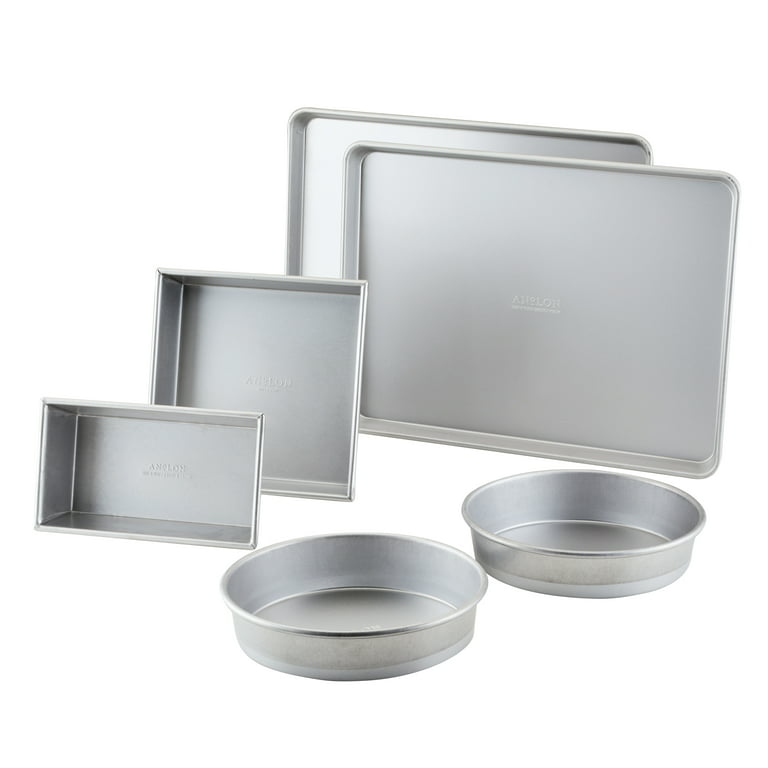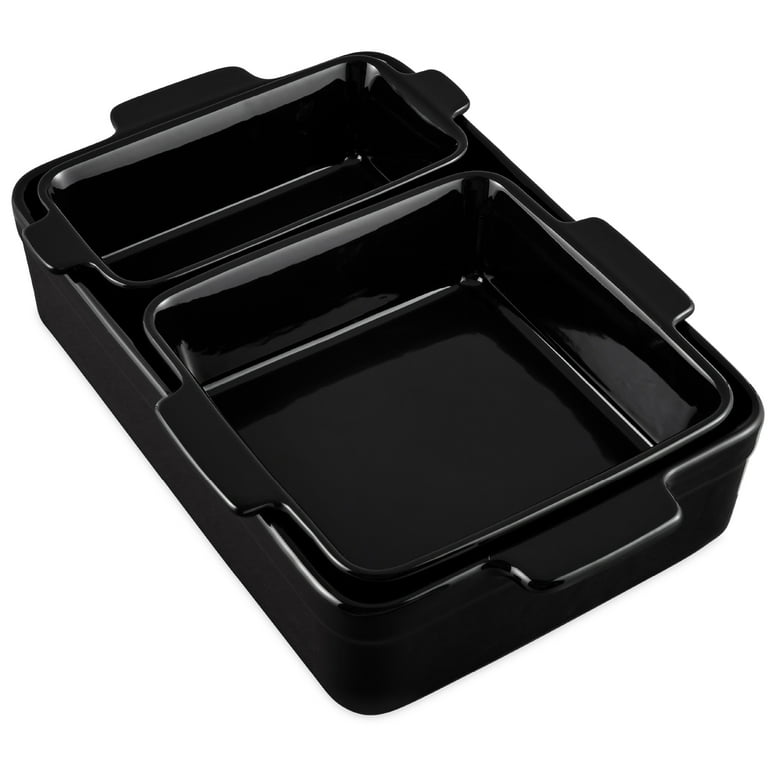Imagine stepping into your kitchen, ready to whip up a delicious batch of cookies or a perfectly baked cake. But, as you reach for your bakeware, you pause.
Does the color of your bakeware really matter? Could it be the secret ingredient to achieving that golden crust or moist center? You might be surprised to learn that the color of your bakeware can indeed make a difference in your baking results.
We’ll dive into the science behind bakeware colors and how they can impact your culinary creations. Whether you’re a seasoned baker or just starting out, knowing which color to choose could be the key to unlocking your baking potential. Stay with us to discover how the hue of your bakeware can elevate your baking game from ordinary to extraordinary.

Credit: www.walmart.com
Factors Influencing Bakeware Color Choice
Choosing the right color for bakeware can impact your baking results. Factors like heat absorption, aesthetics, and durability play significant roles. Understanding these elements helps in making informed decisions for your kitchen.
Heat Absorption And Distribution
Dark-colored bakeware absorbs more heat compared to lighter shades. This can lead to faster cooking times. It is ideal for foods needing crispy edges. Light-colored bakeware reflects heat, offering slower cooking times. Perfect for delicate treats that require gentle baking. Different colors can affect heat distribution in your oven. Choose bakeware based on your specific baking needs.
Aesthetic Appeal
Bakeware colors can enhance your kitchen’s look. Bright colors add a pop of fun to your baking experience. Neutral tones offer a classic and timeless appeal. The choice of color can reflect your personal style. It can also complement your kitchen decor. Selecting bakeware with pleasing colors can make cooking more enjoyable.
Durability And Maintenance
Some colors may show stains or scratches more easily. Dark colors often mask imperfections better than lighter ones. Consider bakeware with finishes that are easy to clean. Certain coatings are more resistant to wear and tear. Durable bakeware requires less maintenance and lasts longer. Choosing wisely ensures your bakeware remains in top condition.

Credit: www.walmart.com
Popular Bakeware Colors
Choosing the right bakeware color enhances your baking experience. Color affects heat absorption and reflection, impacting your baking results. Popular bakeware colors like silver, black, and vibrant ceramics offer unique benefits. Each color has its own charm and functionality. Explore the common colors found in bakeware today.
Traditional Silver And Aluminum
Traditional silver and aluminum bakeware is a classic choice. It reflects heat evenly, ensuring balanced baking. This color helps prevent over-browning. Silver bakeware is durable and resists rust. It’s easy to clean, making it a favorite in many kitchens.
Nonstick Black
Nonstick black bakeware absorbs heat efficiently. It heats up faster, which speeds up baking times. The dark surface can enhance browning for certain dishes. Nonstick coatings prevent food from sticking, simplifying cleanup. This color is practical for frequent bakers.
Vibrant Ceramic Colors
Vibrant ceramic bakeware adds a pop of color to your kitchen. These come in red, blue, green, and more. Ceramic retains heat, keeping food warm longer. It’s often used for serving directly from oven to table. The colorful designs make them a delightful addition to your kitchen decor.
Performance Comparison
Choosing the right color for bakeware can affect your baking results. Different colors can influence how your baked goods turn out. Let’s compare the performance of various bakeware colors. We’ll explore how they affect browning, cooking evenness, cleaning, and baking time.
Browning And Cooking Evenness
Dark-colored bakeware absorbs more heat. This can lead to quicker browning. It may cause uneven cooking if not monitored. Lighter colors reflect heat. They provide a more consistent bake. Choose wisely based on your baking needs. Consider what you bake most often.
Ease Of Cleaning
Some colors show stains more easily. Dark bakeware might hide stains better. But it can also show scratches and marks. Light-colored bakeware may need more frequent cleaning. It reveals food residue more clearly. Non-stick coatings can help with cleaning. Choose bakeware that fits your cleaning preferences.
Impact On Baking Time
Dark colors can shorten baking time. They conduct heat more efficiently. Be careful to avoid overbaking. Monitor your baked goods closely. Light-colored bakeware might require longer baking. It is less likely to burn your treats. Consider adjusting baking times based on bakeware color.
Color Impact On Baking Results
Bakeware color can change your baking results. It affects how heat is absorbed and distributed. This can alter how your baked goods cook and brown. Understanding these effects helps in choosing the right bakeware color for your needs.
Dark Vs Light Colors
Dark-colored bakeware absorbs more heat. This can lead to quicker browning. It might result in over-baking if not carefully monitored. Light-colored bakeware reflects heat. This slows down the cooking process. It helps prevent over-browning, especially with delicate items.
Reflective Vs Matte Finishes
Reflective bakeware surfaces can influence baking times. They bounce heat away, leading to longer baking periods. This might be ideal for recipes needing gradual cooking. Matte finishes absorb heat more efficiently. This can speed up the baking process. It may require adjustments in baking times or temperatures.
Choosing The Right Color For Your Needs
Bakeware color affects baking results and aesthetic appeal. Different colors impact heat absorption and distribution. Choosing the right color depends on your baking goals and environment. Each type of baker has unique needs. Understanding these can help you make the best choice.
For Beginners
Beginners benefit from lighter colored bakeware. Light colors reflect heat more evenly. This helps prevent over-baking and burning. It’s easier to monitor progress with lighter surfaces. Perfect for those learning to bake.
For Professional Bakers
Professional bakers often prefer darker bakeware. Dark colors absorb heat quickly and provide crisp edges. This is essential for pastries and breads. Dark bakeware ensures professional results. Ideal for those with experience.
For Home Enthusiasts
Home bakers enjoy experimenting with colors. Medium shades offer balance between heat absorption and distribution. These colors are versatile for various recipes. They enhance the kitchen’s aesthetic. Suitable for hobbyists and frequent bakers.
Expert Recommendations
Choosing the right color for bakeware can affect cooking results. Dark colors absorb heat faster, leading to quicker baking. Light colors reflect heat, providing slower and more even cooking. Experts suggest considering recipe type and desired outcomes when selecting bakeware color.
When selecting bakeware, color might not be the first thing you consider. However, experts agree that the hue of your baking pans can significantly impact your baking results. Colors can affect the baking process by influencing heat absorption and distribution, thus altering cooking times and even the texture of your baked goods. To help you make the best choice for your kitchen, we’ve gathered insights from baking experts on the best colors for bakeware.Top Picks For Everyday Baking
For daily baking tasks, experts often recommend light-colored bakeware. These pans, usually in shades of silver or gold, reflect heat rather than absorb it. This helps in achieving even cooking and prevents the bottoms of cookies or cakes from browning too quickly. Next time you’re baking your favorite cookies or a simple cake, consider using light-colored pans to reduce the chance of burning. Personally, I’ve seen a noticeable difference in my chocolate chip cookies’ texture since switching from dark to light bakeware. The bottoms are no longer overdone while the tops remain perfectly soft and chewy.Special Occasion Bakeware Choices
Planning to bake for a special occasion? Dark-colored bakeware might be your go-to. These pans absorb more heat, which can be beneficial for dishes that require a crispy crust or a well-caramelized surface. Think of it as giving your baked goods a sun-kissed finish. For instance, when baking a rich chocolate cake for a friend’s birthday, using a dark pan can enhance the depth of flavor and texture. However, you might need to adjust the baking time slightly to avoid overcooking. Have you ever wondered why some cakes taste richer and more decadent than others? The secret might just be in the pan color. Choosing the right color for your bakeware can elevate your baking game. Next time you’re shopping for bakeware, consider what you plan to bake most often and how the color might affect your results. Which will you choose for your next baking adventure?:max_bytes(150000):strip_icc()/__opt__aboutcom__coeus__resources__content_migration__serious_eats__seriouseats.com__2019__10__20191003-cast-iron-skillet-testing-vicky-wasik-primary-1500x1125-5b124e1ba2de4139a1e72df7246222b6.jpg)
Credit: www.seriouseats.com
Frequently Asked Questions
What Color Bakeware Is Most Popular?
The most popular color for bakeware is dark or matte gray. It is favored for its ability to absorb heat effectively, leading to even baking. Dark-colored bakeware is often preferred for achieving a nice, golden-brown finish on baked goods.
Does Bakeware Color Affect Baking Results?
Yes, bakeware color affects baking results significantly. Darker bakeware absorbs more heat, leading to quicker browning and cooking. Lighter-colored bakeware reflects heat, resulting in slower baking. Understanding these differences can help in achieving desired baking outcomes, such as perfectly browned cookies or cakes.
Why Choose Dark-colored Bakeware?
Dark-colored bakeware is chosen for its heat absorption efficiency. It helps in achieving even cooking and browning. This type of bakeware is ideal for recipes requiring a crispy or golden finish. Additionally, it is often non-stick, making it easier to clean and maintain.
Is Light-colored Bakeware Better For Certain Recipes?
Light-colored bakeware is ideal for delicate recipes. It prevents over-browning and ensures gentle, even cooking. This type of bakeware is perfect for cakes and pastries that require a lighter finish. It helps in achieving a soft texture without the risk of burning.
Conclusion
Choosing the right bakeware color matters for baking success. Dark bakeware absorbs heat, cooking food faster. Light bakeware reflects heat, for slower, even baking. Consider your recipe needs. Dark pans work well for crispy edges. Light pans are ideal for gentle baking.
Your kitchen’s style can also guide your choice. Coordinate bakeware with your decor. Remember, functionality should come first. Experiment with both colors. Find what suits your baking style. Happy baking!


